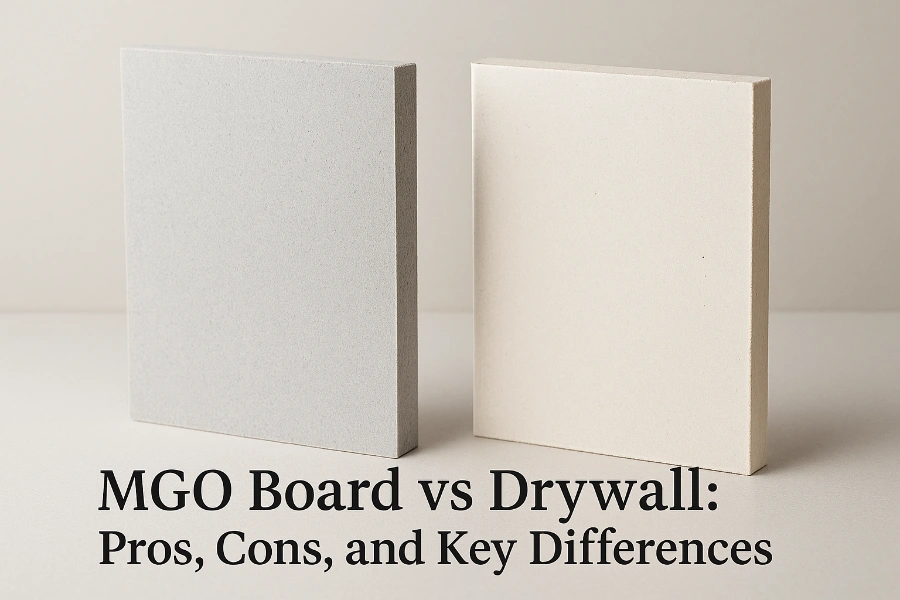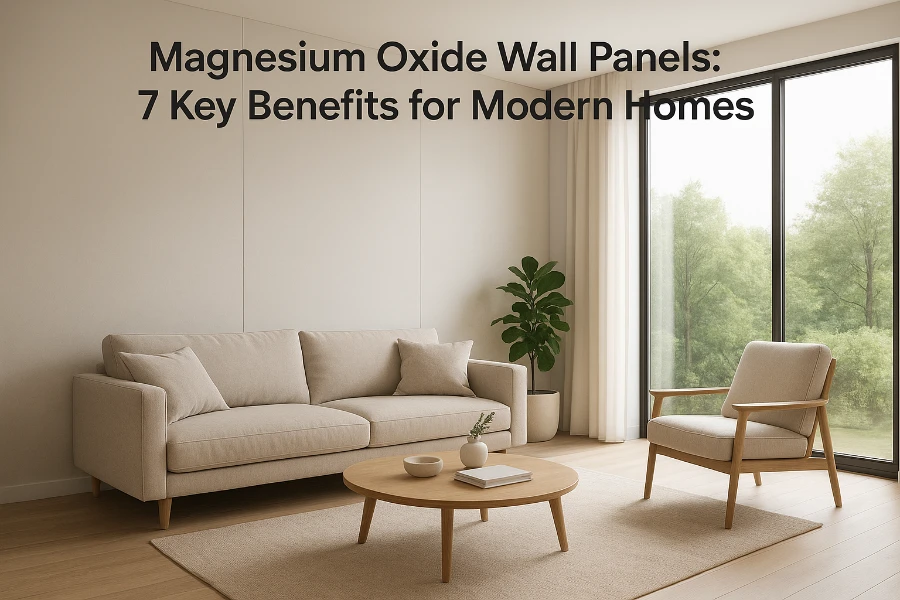Table of Contents
Introduction to Gypsum Board
Gypsum board, also known as a gypsum panel, is a widely used construction material made primarily from natural gypsum sandwiched between paper layers. It provides a smooth, flat surface ideal for walls and ceilings in both residential and commercial buildings. Its lightweight nature allows for easier handling and faster installation compared to traditional masonry or plaster.
Gypsum panels are highly versatile, serving as a base for painting, wallpapering, or decorative finishes. They are commonly used in interior partition walls, false ceilings, and wall cladding, providing both functional and aesthetic benefits. While gypsum panels offer numerous advantages, certain conditions—such as high moisture environments—may call for alternative materials like magnesium oxide (MgO) boards, which provide superior moisture and fire resistance.
7 Key Benefits of Gypsum Board
Gypsum board, also referred to as a gypsum panel, has become a staple in modern construction due to its combination of functionality, affordability, and versatility. Here are the seven key benefits that make gypsum panels a preferred choice for architects, builders, and homeowners alike:
1. Fire Resistance
One of the standout features of gypsum board is its natural fire-resistant properties. The core of gypsum panels contains chemically combined water, which releases as steam when exposed to heat, slowing down the spread of fire. This property makes gypsum boards an excellent choice for interior walls and ceilings, providing an added layer of safety in both residential and commercial buildings. While materials like MgO boards offer even higher fire resistance, gypsum panels still provide a reliable level of protection for standard construction needs.
2. Lightweight and Easy Installation
Gypsum panels are significantly lighter than traditional masonry materials, which translates to faster installation and reduced labor costs. Builders can easily cut, shape, and mount gypsum boards using standard tools, allowing for efficient construction even in complex designs. Their lightweight nature also minimizes structural load on buildings, making them suitable for multi-story constructions where weight considerations are critical.
3. Smooth Finish for Interiors
Gypsum boards provide a smooth and uniform surface that is ideal for various finishing options, including painting, wallpapering, or applying textured finishes. This makes gypsum panels a favorite among interior designers and homeowners who value a clean, professional appearance without extensive plaster work. The uniform surface reduces preparation time and ensures consistent results across walls and ceilings.
4. Acoustic Performance
Gypsum panels are well-regarded for their soundproofing qualities. When installed correctly, they can significantly reduce noise transmission between rooms, creating a more comfortable indoor environment. This feature is particularly valuable in commercial buildings, offices, and residential apartments, where privacy and noise control are essential.
5. Thermal Insulation
Gypsum boards also contribute to thermal insulation, helping to maintain stable indoor temperatures. By reducing heat transfer through walls and ceilings, gypsum panels can improve energy efficiency and reduce heating or cooling costs. While not as thermally resistant as some specialized materials, gypsum panels offer a good balance of insulation, cost, and ease of installation.
6. Cost-Effectiveness
Compared to alternative materials, gypsum boards are economical and widely available, making them a cost-effective solution for a wide range of projects. The combination of low material cost, ease of handling, and reduced labor requirements makes gypsum panels a smart choice for budget-conscious construction while maintaining quality and safety standards.
7. Eco-Friendly Attributes
Gypsum is a natural material, and many gypsum panels are produced using recycled content, making them environmentally friendly. They are free from harmful chemicals and contribute to sustainable construction practices. For projects that require additional eco-benefits, materials like MgO boards can complement gypsum panels, offering higher durability and resistance while remaining sustainable.

Limitations of Gypsum Board
While gypsum board, or gypsum panels, offers numerous advantages, it is important to understand its limitations to make informed decisions for construction projects. Awareness of these drawbacks helps builders and homeowners select the most appropriate materials for different environments.
1. Moisture Sensitivity
One of the main limitations of gypsum panels is their vulnerability to moisture. Standard gypsum boards can absorb water, leading to swelling, sagging, or even mold growth if exposed to prolonged damp conditions. This makes them less suitable for areas such as bathrooms, kitchens, or exterior walls. For moisture-prone locations, alternatives like magnesium oxide (MgO) boards and cement boards are often preferred due to their superior moisture resistance.
2. Impact Resistance
Gypsum boards are relatively soft and prone to dents or cracks from heavy impacts. While they work well for normal interior walls, areas that experience frequent contact—like corridors, high-traffic commercial spaces, or children’s rooms—may require additional protection, such as corner guards or more durable materials like MgO panels.
3. Limited Durability in Harsh Conditions
Although gypsum panels are widely used in standard construction, their long-term durability can be limited under extreme conditions. They are less resistant to high humidity, continuous vibration, or mechanical stress compared to some alternative boards. In projects where high strength, fire resistance, and moisture tolerance are crucial, materials like MgO boards can complement gypsum panels and provide a more robust solution.
4. Specialized Installation Requirements
While gypsum panels are generally easy to install, achieving perfect finishes requires careful handling, joint taping, and sometimes additional finishing layers. Poor installation can lead to visible seams, cracking, or uneven surfaces. Builders must follow proper installation practices to maintain the panel’s aesthetic and functional qualities.
Considering Alternative Materials
While gypsum boards are suitable for most standard construction projects, certain conditions may call for alternative materials. For instance, environments with high moisture, heavy mechanical stress, or enhanced fire safety requirements may benefit from boards with higher durability.
Magnesium oxide (MgO) boards are a notable alternative in such cases. MgO panels offer superior moistureand fire resistance, along with higher impact strength compared to traditional gypsum panels. They are also environmentally friendly and can be used in both interior and exterior applications. While they may come at a slightly higher cost, MgO boards provide a long-term solution for projects that demand robust performance and longevity.
By understanding the strengths and limitations of gypsum boards, designers and builders can decide whether to rely solely on gypsum panels or integrate alternative materials like MgO boards for critical areas.
Conclusion
Gypsum boards, also known as gypsum panels, remain one of the most versatile and cost-effective building materials available. They offer fire resistance, easy installation, smooth finishes, acoustic and thermal benefits, affordability, and eco-friendly attributes. However, they also come with limitations, including moisture sensitivity, lower impact resistance, and reduced durability in harsh conditions.
For projects where these limitations could impact performance, MgO boards or other alternative materials may complement gypsum panels, providing enhanced durability and safety.
Choosing the right material depends on project requirements, environmental conditions, and long-term performance expectations. For professional guidance on gypsum panels and alternative board options, feel free to contact us today—our experts can help you select the best solution for your construction needs.
How to choose a reliable MGO board supplier: discover key merits of suppliers and magnesium oxide boards for safe, durable, and eco-friendly construction.
Compare MGO board vs drywall to understand their pros, cons, and key differences. Discover which wall material suits your project best.
Discover 7 key benefits of magnesium oxide wall panels for modern homes, from fire resistance and moisture protection to durability and eco-friendliness.




